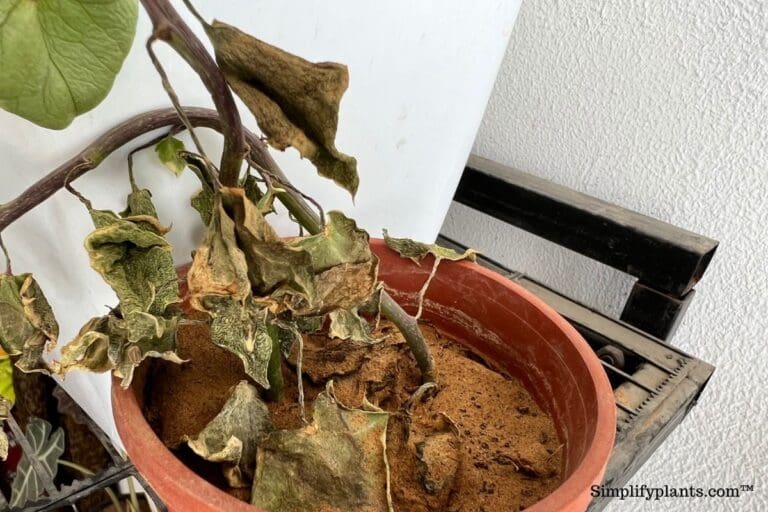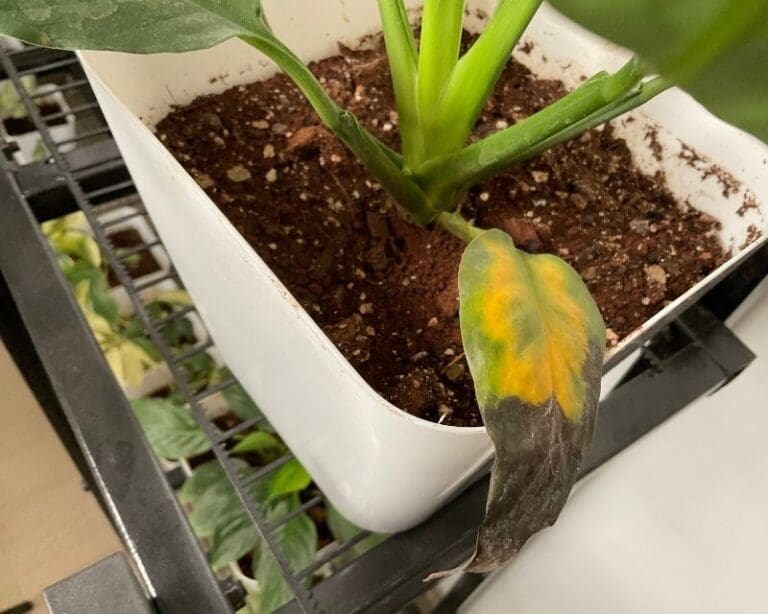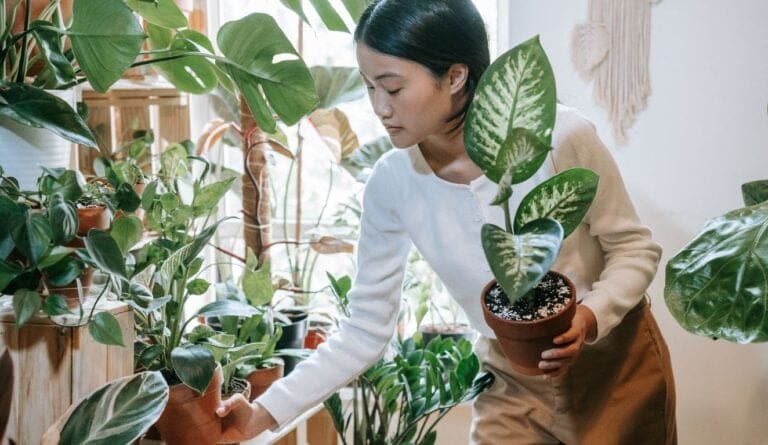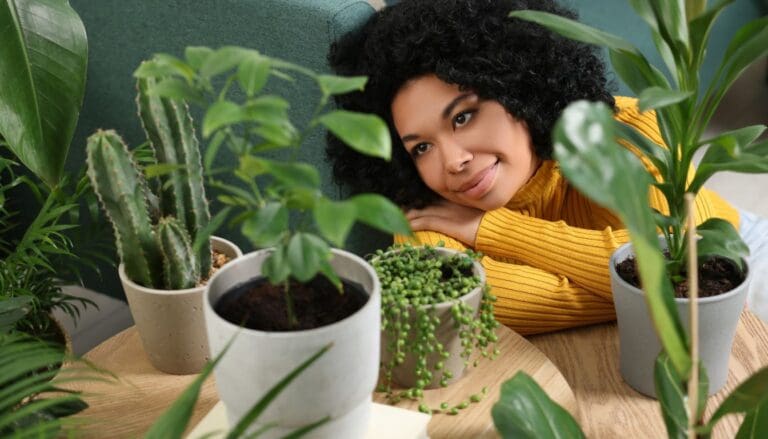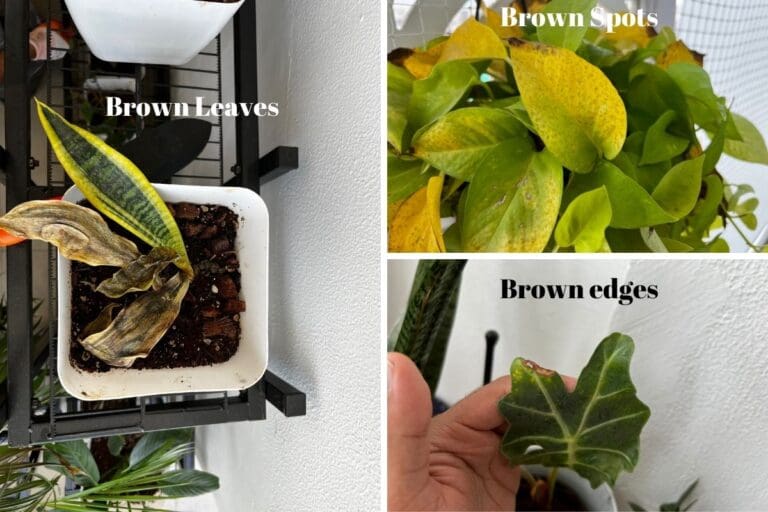How To Dispose Of Potted Plants? (8 Unique Ways)
Potted plants will die at the end of the growing season or due to old age or cultural issues. So, what should we do with them? Do we need to dispose of them completely, or can we use them for other purposes? Let’s find out.
Any plants with irrecoverable damage need disposal. There are many ways of disposing of potted plants: burning, burying, discarding in landfills, nearby dumping areas, or in your garbage. If you want to dispose of them in an eco-friendly way, make mulch or compost using them.
But before you dispose of the plant, you must check it thoroughly to look for signs indicating whether you should throw it away or if it has a chance of survival. To know the different ways of disposing of the plant, read this article till the end.

Please note: Simplify Plants is reader-supported. Some links in the post are affiliate links and I get a commission from purchases made through links in the post.
Should we dispose of the potted plants?
When a plant is old, dead, or too damaged, there is no other option than to dispose of it.
If your houseplant looks withered, weak, and floppy, and you don’t see any growth in them, you might decide to dispose of them.
But before you take this strict decision, you must check the condition of your plants very closely.
Sometimes, the plants may look withered and weak but are not yet dead.
There are still chances of revival.
If you dump them without checking their condition, you are probably losing some good plants that you could have saved and helped them thrive again for some more time.
So, if you don’t want to face such situations, consider checking the plants’ conditions.
Here is how you should check its condition:
Inspect the leaves
First of all, check the leaves.
The plant is dead if all the leaves are withered and have turned yellow or brown.
But if some leaves are still green and in good condition, it is not yet dead.
You still have the chance to revive it.
During pest attacks or fungal infections, all the leaves look withered.
Reviving is a bit difficult if most of the leaves have withered and been damaged.
Growers try treating the plant one.
But if the plant doesn’t show signs of return, growers discard the plant.
But if a few leaves have been affected, you can treat the plant and bring it back to life.
Have a look at the stems
If the stems are brown or yellow, then the plant is dead.
But before declaring the plant dead, consider scratching the stems to check the inside of the stems.
If the inside layers of the stems are still green, your plant is not yet dead and can be saved.
Sometimes, the plant looks dead due to dormancy.
In winter, many plants die back to the ground and return when the weather is normal.
Scratching the stems is one of the best ways to confirm whether the plant is dead.
Check the roots

Check the roots when the plant is not developing and all the leaves are limp or discolored.
Remove the plant from the pot and observe the roots closely to check the roots.
If the roots are white and firm, the plant is still healthy and will remain alive for some more time.
But if the roots are black, mushy, or extremely dry, the plant is dead.
However, if only a few roots have become black, soft, and dry, and the rest are still firm, you can revive the plant.
How should you dispose of the potted plants?
There are several ways of disposing of potted plants.
Generally, the plants are dumped in landfills or nearby dumping areas.
Or, they are transferred to the transfer stations or taken to the recycling centers for recycling.
However, there are several ways of disposing of the plants.
Below are some of them:
Burn them in fireplaces
Plants can get attacked by various pests and diseases if not taken care of well.
Just because they are growing inside doesn’t mean they are safe from bugs.
If conditions are made favorable, the plants will have infestations.
If the plants are so hurt that revival is impossible, you must discard them.
You can’t even use these plants for other good purposes like mulching.
If you use it, the infestation will spread to the other good plants.
One good option is to burn them down.
If you have a wood-burning fireplace inside your home, put the plant parts into that fireplace.
Make sure that no plants are near the fireplace.
Or, burn them down outdoors, away from your garden bed.
However, it would be best not to overdo the burning because excessive burning can lead to mold allergens.
Dispose of plants by using a wood chipper
If you need to dispose of many potted plants together, you can use wood chippers to destroy and discard them.
Using a chipper is a great way to dispose of large amounts of potted plants in a short time.
By destroying the plant into pieces, dumping also gets easier.
A full-grown plant can take a lot of space in your trash can.
Grinding the plants into pieces takes smaller space.
Dispose of in yard-waste
Some areas have regular yard-waste pick-up arrangements.
The people from the yard-waste companies will come and take your waste daily.
If you collect the dead plant parts in a bag, the person coming to take them will take these bags and send them to yard-waste recycling centers.
The centers will grind these plants into small pieces to make them as compost and mulch and resell them.
If you wish to dispose of the plants this way, your plants don’t get discarded completely.
They further get used.
But, if the plant is diseased or infested, it is better to dump them in the dumping area or garbage because using them as mulch can transfer the disease to other plants.
Though most people use infested plants as compost, I won’t recommend using these plants as compost.
You should dump them instead of adding to the yard waste.
Bury the plants
Instead of just throwing them in the trash can, you can bury those dead plants to dispose of them.
It is because some yard-waste centers reuse them as mulch and compost.
So, if pests and diseases infect your plant, the beds mulched with these dead plant parts can get infected by the same disease.
Dig a hole in your backyard, throw the potted plants in the hole, and cover them with soil.
Don’t leave any plant parts outside in the garden.
Recycle the plants
If you want to replant the dead or old plants again, you can take them to the nurseries or home improvement stores.
These stores can help recycle the plant for you.
That way, you don’t have to dispose of the potted plant entirely.
If the plant still has some life left, the employees can help you in recycling the plant.
Dispose of them in a trash can
The easiest way to dispose of the potted plants is to take them out of the pot and throw them in the trash can.
Keep the yard-waste plastics over the discarded house plants to prevent the foul odor from entering your kitchen or other rooms.
Can I use the plant parts instead of throwing them away?
Instead of disposing of the entire plant/s in the garbage or dustbin, you can use them for good things.
By reusing the plant parts, you can get rid of those plants, but you are not throwing them off.
Here are some ways to use dead or old plants for good reasons:
Composting

Without throwing the plant, you can use the plant remnants for composting.
This way, you dispose of the plant without completely throwing it away.
Using the plant parts for composting increases the quality of the compost.
Adding this compost to the soil can improve the soil quality.
Choose a space away from your home for composting because it will release a foul smell after some days.
Take all the discarded leaves, grass clipping, and plant parts like the leaves and compile them in a compost bin.
It is better not to make the pile too much, as you have to turn them after every few weeks with a stick.
Too much can make turning difficult.
Keep the compost moist.
Turning every few weeks will allow the compost to receive some air.
Within a few months, the compost will be ready.
Many people recommend adding pest-infested or fungus-infected plants to the compost pile.
When the leaves get composted, they reach a temperature of nearly 150-180°F, enough to kill any fungus or pests.
But, sometimes, the temperature fails to reach such a range.
As a result, the pathogens and pests remain alive.
I never add diseased or pest-infested plants to the compost pile.
So, I would also recommend not adding those plants to compost.
Mulching
You can use the houseplant pieces like the leaves and stems for mulching, pine needles, dry leaves, and grass clippings to mulch your outdoor garden beds.
So, you did dispose of the plant, but you are not throwing them completely.
To dispose of the potted plants better, break them down into fine pieces, dry them in the sunlight, and then use them for mulching your garden beds outside.
Letting the plant parts dry out in the sunlight kills the living seeds.
Otherwise, these seeds will, later on, create weeds on your garden beds.
Never use diseased plants or pest-infested plants for mulching.
Use it purposefully without throwing them away.
It is an eco-friendly way of disposing of potted plants.
Here, you are destroying the plant but not completely discarding it into the garbage.
You can use the plant parts of your houseplants in art and craft projects.
You can add dried leaves in art and craft to set up in the house as home decor.
The flowers and stems can be used in making aromatic potpourri.
What should I do with the potting soil of the disposed of plants?

Using the same old potting soil for planting new houseplants is not good.
The old soil could get depleted or get infected by diseases.
However, you can recycle the potting soil if you have recently repotted your dead or old houseplant before death.
You can add some ingredients to the potting soil to help them regain its qualities, like drainage, fertility, retention, aeration, mineral level, etc.
As I said earlier, recycling the potting soil will only work if it is pest and disease-free.
The same goes for the plants too.
Another risk is using old potting soil deficiency is mineral level.
An extreme lack of minerals can kill the newly planted houseplants.
If the soil is not in a very good condition, it is better to discard them in a landfill or nearby dumping area.
Or, you can take the soil to the transfer station and recycling centers if you don’t know what to do with it.
Final thoughts
There are several ways of disposing of potted plants. Just take them out of the pot and discard them in the landfills, dumping areas nearby, or garbage. You can even bury them or burn them in the fireplaces.
If you don’t want to discard the old plants but want to use them for good reasons, you can use them in composting, mulching, and artful works and projects.
The potted plants will only be reused as compost or mulch if they remain healthy. If they get infected, you don’t have any option other than to dump them. You can also use the potting soil if it is still in good condition and healthy. Otherwise, it is better to use new soil for new plants.
However, you don’t have to throw away the pots with the soil or plant. You can use the old ones after disinfecting them with bleaching powder.
Sources: Effects of Plant Growth Retardants and Pot Sizes on Plants, Pot size matters.
Recommended Garden Supplies
| Product Image | Our Recommended Gardening Supplies | Check Offers! |
|---|---|---|
Top Top
Top
Top
Top
Top
Top
Top
Top | rePotme Houseplant and Tropical Classic Potting Soil Mix | Check Offer On Amazon |
 Top
Top
Top
Top
Top
Top
Top
Top | Espoma Organic Indoor Plant Food | Check Offer On Amazon |
 Top
Top
Top
Top
Top
Top
Top
Top | GooingTop LED Grow Light 6000K Full Spectrum Clip Plant Growing Lamp | Check Offer On Amazon |
 Top
Top
Top
Top
Top
Top
Top
Top | Soil Moisture Meter | Check Offer On Amazon |
 Top
Top
Top
Top
Top
Top
Top
Top | Govee Hygrometer Thermometer, Bluetooth Enabled! | Check Offer On Amazon |
 Top
Top | LEVOIT Humidifiers for Large Room(Best For Plants) | Check Offer On Amazon |
 Top
Top
Top
Top
Top
Top
Top
Top | Upgraded DIY Automatic Drip Irrigation Kit, 15 Potted Houseplants Support | Check Offer On Amazon |
 Top
Top
Top
Top
Top
Top
Top
Top | Stainless Steel Heavy Duty Gardening Tool Set | Check Offer On Amazon |
 Top
Top
Top
Top
Top
Top
Top
Top | Bonide Insecticidal Soap | Check Offer On Amazon |
 Top
Top
Top
Top
Top
Top
Top
Top | Bonide 32 oz Spray Neem Oil for Organic Gardening | Check Offer On Amazon |
 Top
Top
Top
Top
Top
Top
Top
Top | Garden Safe Fungicide | Check Offer On Amazon |


